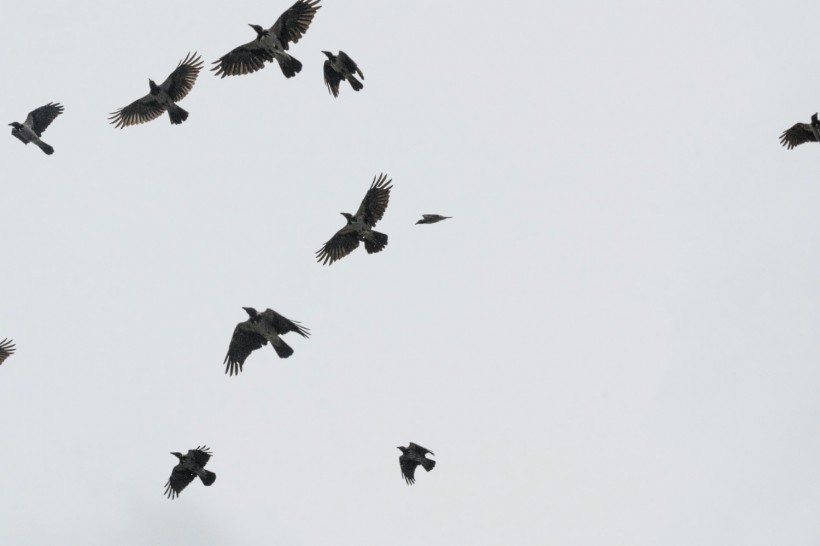
The eerie sight of a murder of crows in a city in Maine is getting worse, according to locals.
The "murder of crows," a persistent flock of crows that hover over a Maine city, is starting to annoy the locals and create an eerie nighttime skyline.
Eerie, Noisy, and Getting Worse
Lewiston residents are grappling with a nightly phenomenon: a dense flock of crows soaring overhead, causing persistent issues.
The athletic director of Lewiston acknowledges the ongoing problem, highlighting the heightened challenge this year, particularly concerning the aftermath left by the birds.
The Franklin Athletic Complex field requires regular treatment, including repellants, to deter the birds.
Resident Chris Robley describes a surreal scene of crows infiltrating backyards and lining trees, with a recent eerie sighting that gave him goosebumps.
Jenna Palazzolo, another resident, notes the crows' overwhelming noise, especially in her neighbor's yard, expressing annoyance and a collective desire for the birds to depart.
Residents, perplexed by the unexplained crow influx, are puzzled about its cause and hope for a resolution.
Maine Audubon Staff Naturalist Doug Hitchcox sheds light on seasonal behavior, explaining that crows tend to form large roosts during this time for safety and potential communication about food sources.
Despite this insight, the residents remain eager for the disruptive presence of crows to diminish.
Murder of Crows
A group of crows is known as a "murder," a term rooted in folk tales and superstitions.
Crows, part of the Corvidae family, are intelligent and loud, often associated with fear, and considered pests by farmers. Despite their black feathers, crows are social and caring creatures that have intelligence and adaptability in urban and rural areas.
Crows, monogamous and living up to 10 years on average, form strong familial bonds, aiding in roosting and feeding.
Unique to crow communities is their recognition of the dead and "funerals" observed, reflecting their ability to learn about potential threats.
American Crows are common urban wildlife with remarkable intelligence, surviving in various habitats. During spring and summer, they nest in family groups, with the young aiding in raising offspring. In fall and winter, crows forage during the day, forming large communal roosts at night for safety and information exchange.
Protected by the Migratory Bird Act of 1918, harming crows or destroying nests is illegal.
Crows offer a fascinating wildlife spectacle, from family dynamics to communal roosting, inviting appreciation for these often-overlooked creatures.
Also Read: Last 5 'Akikiki Bird Faces Possible Extinction as Non-Native Mosquitoes Bring Malaria to Hawaii
What To Do When Crows Are in The Neighborhood
Crows form communal roosts to survive harsh winters, creating noise and fecal concerns.
Encouraging tolerance, experts advise non-lethal strategies for conflicts, avoiding poisons and legal violations. Displacement methods, like reducing food subsidies and outdoor lighting, can deter roosting.
Active hazing, from noisemaking to scare devices, is effective for smaller roosts; while sound cannons or falconry may help larger ones, requiring professional aid.
Strategies have limitations, and even with hazing, crows stay nearby. Tailored solutions are crucial, balancing effectiveness with ethical considerations to mitigate conflicts and ensure the well-being of crows and other wildlife.
Related Article: 80 Bird Species Named After People to be Renamed by 2024
© 2024 NatureWorldNews.com All rights reserved. Do not reproduce without permission.


![Tsunami Hazard Zones: New US Map Shows Places at Risk of Flooding and Tsunamis Amid Rising Sea Levels [NOAA]](https://1471793142.rsc.cdn77.org/data/thumbs/full/70325/280/157/50/40/tsunami-hazard-zones-new-us-map-shows-places-at-risk-of-flooding-and-tsunamis-amid-rising-sea-levels-noaa.jpg)
![Climate Change is Reducing Dust Levels Worldwide as Arctic Temperature Warms [Study]](https://1471793142.rsc.cdn77.org/data/thumbs/full/70320/280/157/50/40/climate-change-is-reducing-dust-levels-worldwide-as-arctic-temperature-warms-study.jpg)

